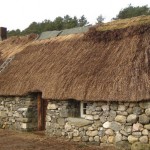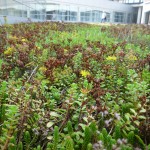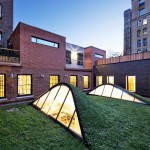City parks and stock exchanges are not the only place to find large expanses of green these days. Green roofs are starting to become part of the cityscape in many of the larger cities on both the East and West coasts. The reason? Green roofs provide a host of environmental benefits: they increase energy efficiency, help reduce the urban “heat island” effect, are aesthetically pleasing, and provide just a little more oxygen to the air. But the main driver behind the proliferation of green roofs is the stormwater control benefit that they provide.
Vegetated roofs — or at least roofs made of vegetation — have been around for a very long time. An example of an old school green roof can be seen on the left. A more modern take, from Philadelphia, can be seen on the right.
Research is showing that green roofs can absorb and transpire anywhere from 40% – 70% of the rainwater that falls on them. Because of this, we are in the early stages of a green roof boom that is being driven by both technology and environmental regulation. On the tech side: older, “intensive” green roofs that involve a thick layer of soil and traditional turf, trees and other plants are being replaced by more feasible “extensive” green roofs. These roofs are made of porous, lightweight planting media and shallow-rooted, low profile plants such as sedums (below left) which can be planted en masse or in small, easily-maneuvered trays (below right).
On the regulation side: most older cities in this country have combined sanitary and stormwater sewers. In large rain storms, the surge of stormwater entering the combined system threatens to overwhelm the sewage treatment plants, and so large volumes of combined sewage and stormwater must be shunted directly into waterways. (If you want help picturing this, here’s a good diagram from the City of Cincinnati.) This is called a CSO, or combined sewer overflow, and almost all cities with this problem are under the regulatory gun to abate it. “Green infrastructure” practices that use vegetation and other natural means of reducing stormwater runoff can be a big part of the solution, and major cities like Chicago, New York and Philadelphia are now embracing these techniques. Chicago has over 5 MILLION square feet of green roof at last count (2010)! Check out the Chicago green roof map here.
So, next time you’re in a low-flying small plane or lounging at your friend’s penthouse, be sure to check out the creeping checkerboard of green blossoming at the top of the cityscape.




